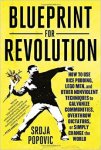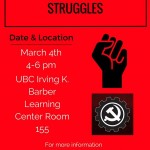
Srdja Popovic was a leader of the Serbian youth movement Otpor!, which organized non-violent opposition to President Slobodan Milošević in the late 1990s. Otpor! was, by all accounts (not least Popovic’s own), remarkably successful: less than two years after the group was formed, and in the wake of the Kosovo war and NATO airstrikes, Milošević was overthrown amid mass demonstrations and at the cost of surprisingly few casualties. After a brief foray into parliamentary politics, Popovic helped to found the Belgrade-based Centre for Applied Non Violent Actions and Strategies, a kind of consultancy for non-violent activism that has advised activists from Egypt, Venezuela, Syria, the Maldives, and elsewhere. Now, with Blueprint for Revolution, he offers us all the lessons he’s drawn from a decade and a half of global protest, from Burma to Yemen, Occupy to the Arab Spring. For as he repeatedly tells us, the principles he proposes “are universal, and they apply no matter who you are and what your problems may be” (244). You, too, he insists, can overthrow a dictatorship and even (or “simply,” as the book’s subtitle has it) change the world.
The book is presented, then, very much as a popular and practical guide. Popovic makes no pretence to be a deep thinker or theorist, and his style is resolutely jocular, sometimes gratingly so. His stress is as much on style as on substance: the very first step for a would-be revolutionary, he tells us, is to come up with a decent logo; as he says of Otpor!, “branding was important to us” (7). And branding is important because protest has to be presented as “cool,” even “sexy.” Popovic reports that Otpor! was so successful at crafting a hip image for revolt that their “little demonstrations became the hottest parties in town” (10). So in line with this dictum, Popovic’s own style (and let’s pass over the presence of a ghost writer, Matthew Miller) is all about being down with the kids. Almost embarrassingly so, though he saves himself by recognizing that at his age he’s probably not as cool as he once was, and by self-deprecatingly acknowledging that ultimately he was never really all that cool anyway. After all, as he repeatedly tells us, he’s a huge fan of Lord of the Rings. So the key is to be hip, but not too hip. Because you don’t want to scare people away. You need to appeal to the broadest cross-section of society possible.
For Popovic is unabashedly populist. And though he doesn’t use the term (which might smack too much of alienating theoreticism), he provides perhaps the best practical definition of populism I have seen:
Take a piece of paper–even a napkin can do the job–and draw a line. Mark yourself on one side of it, and then try to think who could stand together with you. If the answer is just a few people, start over–no matter how committed you are to a cause, or how troubled you are by a problem–and try again. When you’ve managed to place yourself and your friends and just about the rest of the world on one side of the line and a handful of evil bastards on the other, you’ve won. (52)
What this means is the specifics are almost always beside the point. Who cares what the issue is, so long as you can draw that line, construct a “people” in opposition to an evil elite? It might (as in the examples he provides) be a rallying call for cheaper salt (Gandhi) or less dog shit on the streets (Harvey Milk). But then what if the cause that unites people on your side of the line is opposition to immigrants or (Heaven help us) a crackdown on separatism in a breakaway republic? As with all populists, Popovic has little if any means to distinguish between different forms of populism; he’d be at a loss, for instance, if he had to justify supporting Sanders over Trump.
To put this another way: this is a book that’s for revolution, but against politics, “because politics is boring, and we wanted everything to be fun” (11). And in the end, in part because of this, it’s not clear how very revolutionary it is, either. Popovic tells us that a successful movement for social change has to have a vision, because “it’s never enough just to throw a party” (67). But it turns out that the vision that Otpor! had for Serbia was more backward-looking than progressive: “We just wanted a normal country with cool music. That’s it. We wanted a Serbia that was open to the world, as it had been under Tito” (70). For under Tito, Yugoslavia’s official record label had provided young Yugoslavs a steady diet of “the Beatles, David Bowie, Kraftwerk, Whitesnake, and Deep Purple. Growing up in the 1980s, my friends and I barely felt the yoke of dictatorship, busy as we were with great music from around the world” (69). Indeed, if there’s anything revolutionary in Popovic’s proposals, it is a revolution against politics. It’s a call for more bread and (especially) more circuses, more Heavy Metal. It’s a plea for the return of hegemony, or at least its simulacrum, as nostalgically remembered in an idealized childhood homeland that no longer exists.




